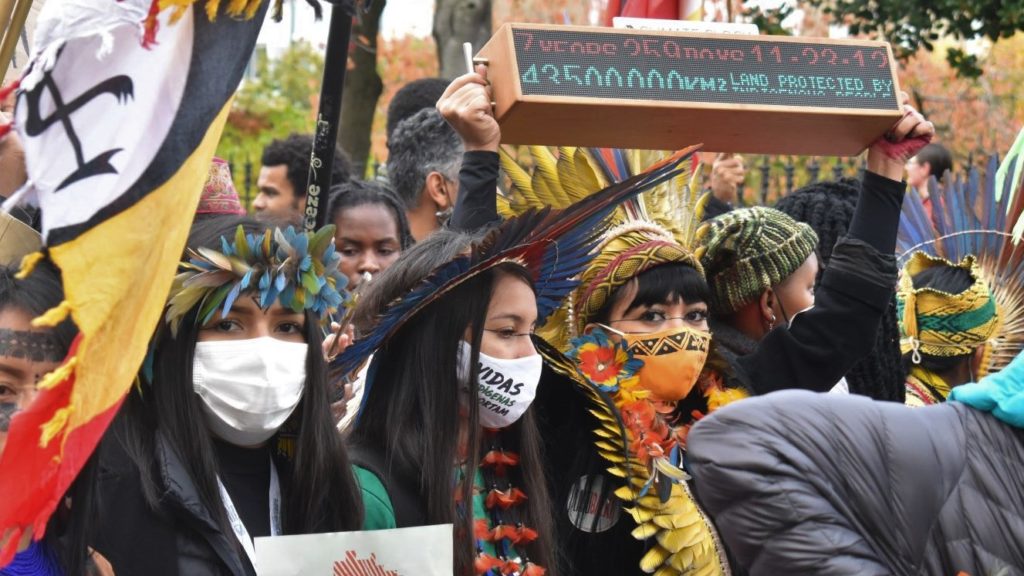It’s a time when us environmentally concerned Natives consider packing our bags — including, more likely than not, some handcrafted items from our prized traditional regalia — and jetting off to whichever far-flung global city is hosting, feathers, beads and ancestors’ dreams in tow.
As droughts intensify, seas rise, forests burn and turn to desert and communities are dislodged from formerly habitable patches of earth, igniting new conflicts over resources and power, First Peoples face a grave and uncertain future.
We stand to lose not just our lands and ways of life, but also our languages and very identities.
Among them was Fawn Sharp, the first woman elected president of the National Congress of American Indians, the body that represents and advocates for American Indians and Alaska Natives in Washington, D.C.
Perhaps unsurprisingly, Sharp has been one of the most outspoken tribal advocates for policies to address and adapt to global warming as well as for justice for the victims of climate change — especially and specifically for the Indigenous.
And while their presence marked a welcome turn towards further Indigenous inclusion and representation at the international level, many participants expressed frustration at what they experienced as a tokenizing dynamic at the climate talks, where world leaders — particularly ones representing liberal regimes — are happy to pose for photos with traditionally garbed Indigenous peoples but are also quick to leave the room whenever one gets on the microphone.
The United Nations Climate Change Conference is organized a bit like a corporation, a bureaucracy or — maybe if you’re more prone to cynicism — like Dante’s Nine Circles of Hell, with concentric spheres of access, influence and sin.
In Glasgow, Indigenous peoples hoped to ensure their rights were protected in the implementation of emissions trading markets — the kind outlined in Article 6 of the Paris Agreement — which will pay governments, corporations and communities to protect forests as natural carbon sinks.
In coastal British Columbia, for example, First Nations like the Nuxalk have used carbon credit revenues earned through the protection of forests — essential natural sinks that keep carbon in trees rather than in the atmosphere — to fund programs that empower their people as the rightful environmental stewards of their traditional territories.
In California, to cite a different example, the Yurok have protected their forests in an effort to receive carbon credit revenues only to discover that the stringent rules attached to those credits prevent them from using their ancestral lands for traditional uses.
At the end of the day, the inclusion of Indigenous peoples in the text wasn’t all that different from the inclusion of Indigenous peoples in the talks themselves.
“But it has not been delivered.” It seems that this year, like many before, an awful lot of Indigenous peoples travelled to the climate talks to plead for world leaders’ attention by performing a combination of traditional culture and social victimhood, only to be patted on the head.
While part of me wouldn’t mind if Indigenous peoples turned our back on these hypocritical world leaders’ “climate talks,” like the Native guy in Lawrence Paul Yuxweluptun’s aptly titled 1990 painting Red Man Watching White Man Trying to Fix Hole in the Sky, I know that with everything going to shit, that’s not really an option.
Next year, I’m sure many of my friends will pack their bags with their finest Indian clothes for another climate summit where they will mostly be denied a seat at the table and paid little more than lip service.
It was embarrassing, for the cause, to see all the various activists there, who had clearly come by air.
It wasn’t embarrassing to see climate activists flying until after the declaration of “climate emergency”.
I’ll be looking forward to seeing whether Calgary’s new Mayor forbids air travel to herself and senior staff, because you don’t emit a tonne of carbon just to save yourself eight days in a bus or car on a round-trip to Ottawa.
